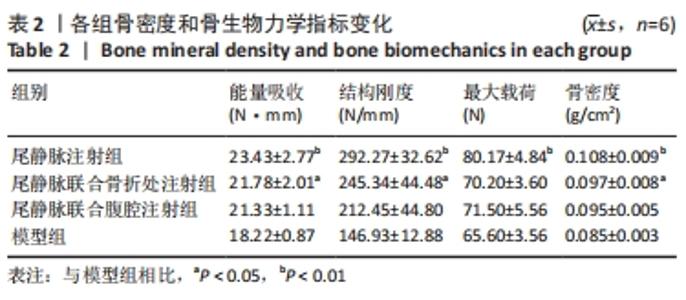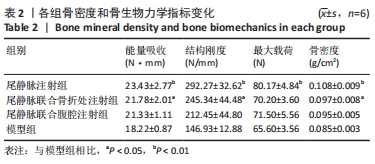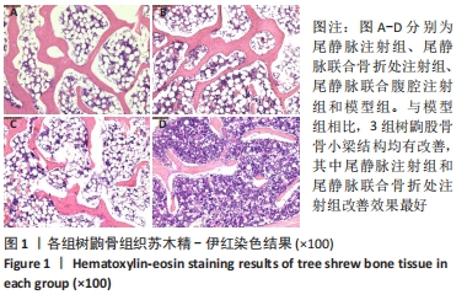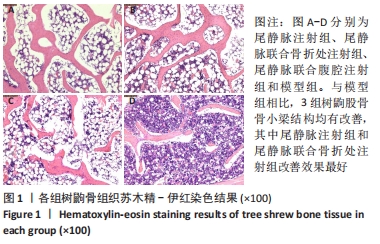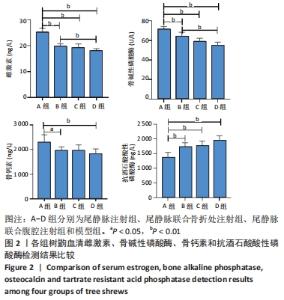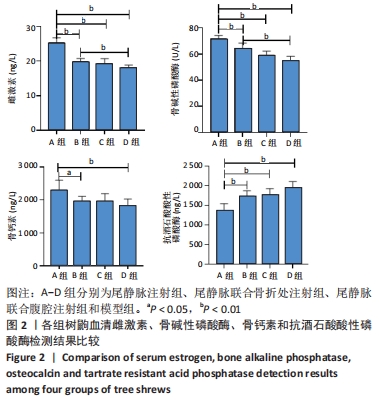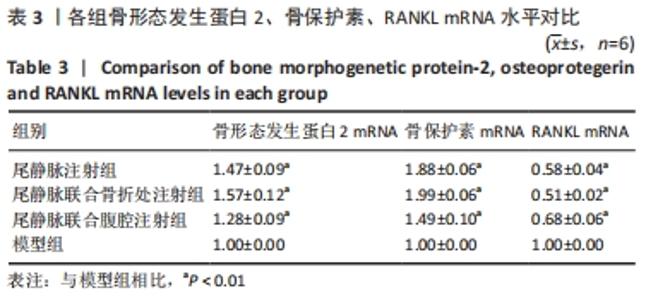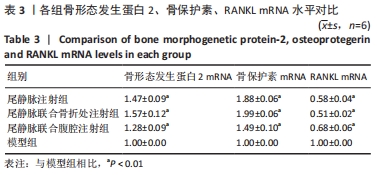Chinese Journal of Tissue Engineering Research ›› 2023, Vol. 27 ›› Issue (6): 909-914.doi: 10.12307/2023.259
Previous Articles Next Articles
Effect and mechanism of different administration routes of placenta-derived mesenchymal stem cells in the treatment of tree shrews with osteoporotic fracture
Huang Guijiang1, Ji Yuwei1, Zhao Xin1, Yang Yi2, Zhao Yulan2, Wang Peijin2, Tang Wei1, Jiao Jianlin2
- 1Department of Science and Education, The First Affiliated Hospital of Kunming Medical University, Kunming 650000, Yunnan Province, China; 2Kunming Medical University, Kunming 650000, Yunnan Province, China
-
Received:2022-01-25Accepted:2022-04-18Online:2023-02-28Published:2022-08-12 -
Contact:Tang Wei, Master, Associate chief pharmacist, Department of Science and Education, The First Affiliated Hospital of Kunming Medical University, Kunming 650000, Yunnan Province, China Jiao Jianlin, Senior experimentalist, Kunming Medical University, Kunming 650000, Yunnan Province, China -
About author:Huang Guijiang, Master, Department of Science and Education, The First Affiliated Hospital of Kunming Medical University, Kunming 650000, Yunnan Province, China Ji Yuwei, Master, Junior pharmacist, Department of Science and Education, The First Affiliated Hospital of Kunming Medical University, Kunming 650000, Yunnan Province, China Huang Guijiang and Ji Yuwei contributed equally to this article. -
Supported by:Special General Project of Applied Basic Research Joint of Yunnan Provincial Department of Science and Technology-Kunming Medical University, No. 2019FE001(-035) (to TW)
CLC Number:
Cite this article
Huang Guijiang, Ji Yuwei, Zhao Xin, Yang Yi, Zhao Yulan, Wang Peijin, Tang Wei, Jiao Jianlin. Effect and mechanism of different administration routes of placenta-derived mesenchymal stem cells in the treatment of tree shrews with osteoporotic fracture[J]. Chinese Journal of Tissue Engineering Research, 2023, 27(6): 909-914.
share this article
Add to citation manager EndNote|Reference Manager|ProCite|BibTeX|RefWorks
| [1] 中华医学会,中华医学会杂志社,中华医学会全科医学分会,等.原发性骨质疏松症基层诊疗指南(2019年)[J]. 中华全科医师杂志, 2020,19(4): 304-315. [2] AL SAEDI A, STUPKA N, DUQUE G. Pathogenesis of Osteoporosis. Handb Exp Pharmacol. 2020;262:353-367. [3] 徐陆晨, 李运峰. 骨质疏松性骨折药物治疗的研究进展[J]. 中国骨质疏松杂志,2017,23(7):947-953. [4] 季雨伟. 胎盘间充质干细胞制剂不同给药途径治疗树鼩OPF的疗效研究[D]. 昆明:昆明医科大学,2021. [5] 张萌, 李荣俊.唑来膦酸治疗老年骨质疏松性骨折的效果及对骨代谢状态的影响[J].中国医学创新,2022,19(2):57-60. [6] 全健, 丁文涛. 自拟补肾健骨汤联合阿仑膦酸钠治疗老年骨质疏松性胸腰椎压缩性骨折患者的临床效果分析[J].贵州医药,2022,46(4): 615-616. [7] SU P, TIAN Y, YANG C, et al. Mesenchymal Stem Cell Migration during Bone Formation and Bone Diseases Therapy. Int J Mol Sci. 2018;19(8): 2343. [8] CHEN XJ, SHEN YS, HE MC, et al. Polydatin promotes the osteogenic differentiation of human bone mesenchymal stem cells by activating the BMP2-Wnt/¦Â-catenin signaling pathway. Biomed Pharmacother. 2019;112:108746. [9] 陈迟迟, 张雨, 何家辰, 等. 肥胖小鼠骨髓间充质干细胞的成骨分化[J]. 中国组织工程研究,2022,26(24):3846-3851. [10] PEREIRA RF, HALFORD KW, O’HARA MD, et al. Cultured adherent cells from marrow can serve as long-lasting precursor cells for bone, cartilage, an d lung in irradiated mice. Proc Natl Acad Sci U S A. 1995; 92(11):4857-4861. [11] KADIYALA S, YOUNG RG, THIEDE MA, et al. Culture expanded canine mesenchymal stem cells possess osteochondrogenic potential in vivo and in vitro. Cell Transplant. 1997;6(2):125-134. [12] GJERDE C, MUSTAFA K, HELLEM S, et al. Cell therapy induced regeneration of severely atrophied mandibular bone in a clinical trial. Stem Cell Res Ther. 2018;9(1):213. [13] PARK YB, HA CW, LEE CH, et al. Cartilage Regeneration in Osteoarthritic Patients by a Composite of Allogeneic Umbilical Cord Blood-D erived Mesenchymal Stem Cells and Hyaluronate Hydrogel: Results From a Clinical Trial for Safety and Proof-of-Concept With 7 Years of Extended Follow-Up. Stem Cells Transl Med. 2016. doi:10.5966/sctm.2016-0157 [14] LEE WS, KIM HJ, KIM K, et al. Intra-Articular Injection of Autologous Adipose Tissue-Derived Mesenchymal Stem Cells for the Treatme nt of Knee Osteoarthritis: A Phase IIb, Randomized, Placebo-Controlled Clinical Trial. Stem Cells Transl Med. 2019;8(6):504-511. [15] DING C, ZOU Q, WU Y, et al. EGF released from human placental mesenchymal stem cells improves premature ovarian insufficiency via NRF2/HO-1 activation. Aging (Albany NY). 2020;12(3):2992-3009. [16] 王燕,杨建成,金毅然,等.间充质干细胞诱导的神经干细胞条件培养基对原代培养海马神经干细胞缺氧损伤的保护作用[J]. 宁夏医科大学学报,2022,44(4):325-331. [17] 崔桂玉,白剑,苗兰英,等. HLA-G阳性的胎盘间充质干细胞体外诱导Treg的实验研究[J]. 中国应用生理学杂志,2018,34(5):396-400. [18] CHRISTODOULOU I, KOLISIS FN, PAPAEVANGELIOU D, et al. Comparative Evaluation of Human Mesenchymal Stem Cells of Fetal (Wharton’s Jelly) and Adult (Adipose Tissue) Origin during Prolonged In Vitro Expansion: Considerations for Cytotherapy]. Stem Cells Int. 2013;2013:246134. [19] YAN X, FU X, JIA Y, et al. Nrf2/Keap1/ARE Signaling Mediated an Antioxidative Protection of Human Placental Mesenchymal Stem Cel ls of Fetal Origin in Alveolar Epithelial Cells. Oxid Med Cell Longev. 2019; 2019:2654910. [20] AGATA H, SUMITA Y, HIDAKA T, et al. Intra-Bone Marrow Administration of Mesenchymal Stem/Stromal Cells Is a Promising Approach for Treati ng Osteoporosis. Stem Cells Int. 2019;2019:4214281. [21] 武羽洁, 袁鑫, 角建林, 等. 两种方法建立树鼩骨质疏松模型的比较实验研究[J]. 医学研究杂志,2019,48(8):51-54. [22] NI X, QIU Z. Tupaiine tree shrews (Scandentia, Mammalia) from the Yuanmou Lufengpithecus locality of Yunnan, China. Swiss J Palaeontol. 2012;131(1):51-60. [23] WANG X, CHEN T, DENG Z, et al. Melatonin promotes bone marrow mesenchymal stem cell osteogenic differentiation and prevents osteopor osis development through modulating circ_0003865 that sponges miR-3653-3p. Stem Cell Res Ther. 2021;12(1):150. [24] WANG Z, WANG D, LIU Y, et al. Mesenchymal Stem Cell in Mice Uterine and Its Therapeutic Effect on Osteoporosis. Rejuvenation Res. 2021; 24(2):139-150. [25] YANG BC, KUANG MJ, KANG JY, et al. Human umbilical cord mesenchymal stem cell-derived exosomes act?via?the miR-1263/Mob1/Hippo signaling pathway to?prevent apoptosis in?disuse osteoporosis. Biochem Biophys Res Commun. 2020;524(4):883-889. [26] ZHAO S, MO X, WEN Z, et al. Declining serum bone turnover markers are associated with the short-term positive change of lumbar sp ine bone mineral density in postmenopausal women. Menopause. 2022;29(3):335-343. [27] FISCHER V, HAFFNER-LUNTZER M. Interaction between bone and immune cells: Implications for postmenopausal osteoporosis. Semin Cell Dev Biol. 2022;123:14-21. [28] FENG X, JIANG S, ZHANG F, et al. Shell water-soluble matrix protein from oyster shells promoted proliferation, differentiation and min eralization of osteoblasts in vitro and vivo. Int J Biol Macromol. 2022; 201:288-297. [29] LADANG A, ROUSSELLE O, HUYGHEBAERT L, et al. Parathormone, bone alkaline phosphatase and 25-hydroxyvitamin D status in a large cohort of 1200 chil dren and teenagers. Acta Clin Belg. 2022;77(1):4-9. [30] CITAK M, GRASMÜCKE D, SUERO EM, et al. The roles of serum alkaline and bone alkaline phosphatase levels in predicting heterotopic ossificati on following spinal cord injury. Spinal Cord. 2016;54(5):368-370. [31] 廖婧, 冯正平. 骨钙素对糖、脂代谢的影响及分子机制的研究进展[J]. 中国骨质疏松杂志,2021,27(3):426-430. [32] ZENGER S, EK-RYLANDER B, ANDERSSON G. Biogenesis of tartrate-resistant acid phosphatase isoforms 5a and 5b in stably transfected MDA-MB-231 breast cancer epithelial cells. Biochim Biophys Acta. 2010;1803(5):598-607. [33] YANG Y, WEI Q, AN R, et al. Anti-osteoporosis effect of Semen Cuscutae in ovariectomized mice through inhibition of bone resorpti on by osteoclasts. J Ethnopharmacol.2022;285:114834. [34] ZHANG W, ZHANG X, LING J, et al. Osteo-/odontogenic differentiation of BMP2 and VEGF gene-co-transfected human stem cells from apical papilla. Mol Med Rep. 2016;13(5):3747-3754. [35] CUI Q, XING J, YU M, et al. Mmu-miR-185 depletion promotes osteogenic differentiation and suppresses bone loss in osteoporosis th rough the Bgn-mediated BMP/Smad pathway. Cell Death Dis. 2019; 10(3):172. [36] CHEN F, LIANG Q, MAO L, et al. Synergy effects of Asperosaponin VI and bioactive factor BMP-2 on osteogenesis and anti-osteoclastoge nesis. Bioact Mater. 2022;10: 335-344. [37] WANG Z, QI G, LI Z, et al. Effects of urolithin A on osteoclast differentiation induced by receptor activator of nuclear factor-κB ligand via bone morphogenic protein 2. Bioengineered. 2022;13(3):5064-5078. [38] UDAGAWA N, KOIDE M, NAKAMURA M, et al. Osteoclast differentiation by RANKL and OPG signaling pathways. J Bone Miner Metab. 2021; 39(1):19-26. [39] 丁海霞, 王富军, 黄晓伟, 等. 不同途径移植脐带血干细胞对兔2型糖尿病的疗效观察[J]. 中华细胞与干细胞杂志(电子版), 2016, 6(6):334-338. [40] 李翰宇. 不同剂量下腹腔注射人脐带间充质干细胞治疗2型糖尿病大鼠的有效性研究[D]. 合肥:安徽医科大学,2019. [41] 徐谷根, 肖毅, 尹卓娜, 等. 不同部位脐血干细胞移植治疗糖尿病大鼠的效果研究 [J]. 中华临床医师杂志(电子版),2015,9(13): 2602-2604. |
| [1] | Ke Yuqi, Chen Changjian, Wu Hao, Zheng Lianjie. Comparison of 12-month follow-up results of primary total hip arthroplasty between modified direct anterior approach and direct anterior approach [J]. Chinese Journal of Tissue Engineering Research, 2023, 27(9): 1377-1382. |
| [2] | Zheng Bo, Zhang Xiuli, Zhou Hao, He Zebi, Zhou Jin, Zhou Weiyun, Li Peng. Arthroscopy-assisted locking hollow screw fixation and open reduction plate internal fixation in the treatment of Schatzker II-III tibial plateau fractures: early CT evaluation [J]. Chinese Journal of Tissue Engineering Research, 2023, 27(9): 1410-1416. |
| [3] | Ruan Ling, Wang Guanghua, Wu Rongping, Jin Zhan, Lyu Zhenqing, Zhang Nan, Li Shoubang. Correlation between exercise intensity and lipid metabolism disorder and oxidative stress in a high-diet rat model [J]. Chinese Journal of Tissue Engineering Research, 2023, 27(8): 1149-1155. |
| [4] | Li Xiaoyin, Yang Xiaoqing, Chen Shulian, Li Zhengchao, Wang Ziqi, Song Zhen, Zhu Daren, Chen Xuyi. Collagen/silk fibroin scaffold combined with neural stem cells in the treatment of traumatic spinal cord injury [J]. Chinese Journal of Tissue Engineering Research, 2023, 27(6): 890-896. |
| [5] | Wang Xiaoge, Liu Jiwen, Yang Shuai, Bao Jinyu, Li Cui. Effects of exercise on depression-like behaviors in chronic unpredictable mild stress rodent models: a systematic review and Meta-analysis [J]. Chinese Journal of Tissue Engineering Research, 2023, 27(5): 813-820. |
| [6] | Song Jian, Zhao Lei, Liu Aishi. Construction and application of myocardial ischemia model in miniature pigs [J]. Chinese Journal of Tissue Engineering Research, 2023, 27(5): 772-778. |
| [7] | Su Meng, Wang Xin, Zhang Jin, Bei Ying, Huang Yu, Zhu Yanzhao, Li Jiali, Wu Yan. Nanocellular vesicles loaded with curcumin promote wound healing in diabetic mice [J]. Chinese Journal of Tissue Engineering Research, 2023, 27(12): 1877-1883. |
| [8] | Zheng Liang, Yu Wen, Yang Fan, Zhao Xiangyi. Eyelid reconstruction in situ using autologous tendon [J]. Chinese Journal of Tissue Engineering Research, 2023, 27(12): 1837-1841. |
| [9] | Tan Xinfang, Guo Yanxing, Qin Xiaofei, Zhang Binqing, Zhao Dongliang, Pan Kunkun, Li Yuzhuo, Chen Haoyu. Effect of uniaxial fatigue exercise on patellofemoral cartilage injury in a rabbit [J]. Chinese Journal of Tissue Engineering Research, 2022, 26(在线): 1-6. |
| [10] | Yao Xiaoling, Peng Jiancheng, Xu Yuerong, Yang Zhidong, Zhang Shuncong. Variable-angle zero-notch anterior interbody fusion system in the treatment of cervical spondylotic myelopathy: 30-month follow-up [J]. Chinese Journal of Tissue Engineering Research, 2022, 26(9): 1377-1382. |
| [11] | Wang Baojuan, Zheng Shuguang, Zhang Qi, Li Tianyang. Miao medicine fumigation can delay extracellular matrix destruction in a rabbit model of knee osteoarthritis [J]. Chinese Journal of Tissue Engineering Research, 2022, 26(8): 1180-1186. |
| [12] | Lü Yiyan, Li Hanbing, Ma Xiaoqing, Zhang Han, Zhang Yuhang, Li Genlin. Establishment and characteristic analysis of interior heat and diabetes mouse model using compound factors [J]. Chinese Journal of Tissue Engineering Research, 2022, 26(8): 1187-1193. |
| [13] | Zhu Chan, Han Xuke, Yao Chengjiao, Zhang Qiang, Liu Jing, Shao Ming. Acupuncture for Parkinson’s disease: an insight into the action mechanism in animal experiments [J]. Chinese Journal of Tissue Engineering Research, 2022, 26(8): 1272-1277. |
| [14] | Wang Xinmin, Liu Fei, Xu Jie, Bai Yuxi, Lü Jian. Core decompression combined with dental pulp stem cells in the treatment of steroid-associated femoral head necrosis in rabbits [J]. Chinese Journal of Tissue Engineering Research, 2022, 26(7): 1074-1079. |
| [15] | Guo Xiaohui, Song Xizheng, Xiang Hanrui, Kang Zhaorong, Li Daming, Kang Yu, Hu Jun, Sheng Kai. External spinal fixation elastic stress in the treatment of jumping spinal fracture [J]. Chinese Journal of Tissue Engineering Research, 2022, 26(6): 919-923. |
| Viewed | ||||||
|
Full text |
|
|||||
|
Abstract |
|
|||||
